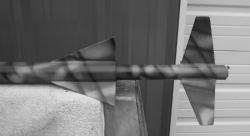Scratch Tigerstrike Missile Original Design / Scratch Built
Scratch - Tigerstrike Missile {Scratch}
Contributed by Casey Smith
| Manufacturer: | Scratch |
Brief:
This rocket is a 2 Stage appearance workhorse that I put together from some
left over 29mm, 38mm, and 54mm motor mount tubing. It has a very long motor
mount tube so it can take a G35 to an I 200. It will probably take an F, but I
never have any.
Construction:
There is the 29mm mount inside of the 38mm tube mounted into the 54mm main body
tube. (The lower section of the kit is 24 inches of 38mm tubing with 24 inches of 29mm tubing inside for a motor mount. The top section is one regular 48 inch long 2.14 tube, with the 8 inch long payload section on top.)
There are 3 24 inch pieces composing the engine mount and lower part of
the main body tube. The rocket has 2 sets of 3 fins, 3 upper, 3 lower, made out
of 3/16 aircraft grade plywood. The nose cone is actually an old balsa nose
cone I had, and it is mounted on a 8 inch payload section for future
electronics bay stuff. I used four centering rings for the 29mm motor mount in
the 38mm lower tube. I used 3 centering rings for the 38 mm tube in the 54mm
upper tube.
I did make the lower fins through the wall attachment, and air-foiled all sides. The top fins are epoxied to the frame, and due to the low profile sonic design, I did not mount them through the wall. I like to build the fin can/mounts very strong, due to if my rockets crash, they come in ballistic, and would like the fin can to survive. I did wrap a coat of 2 ounce fiberglass to the lower body tube to beef up it's strength on impact. the upper main body tube could actually use an extra staging coupler or 2 pushed inside to strengthen it in the middle, or just make it shorter. I did put 4 holes in the payload section and ran bailing wire in there to give it a scale like look with 4 antennae. This kit is super sturdy, on line with PML. I put a small threaded rod like Cosmodrome uses for motor retention and just use a small square nut, works great.
Flight:
I have flown this kit 5 times, 3 on G64-M reloads, 1 on a G40-7 and also an
H220-M. I do use that cellulose insulation for wadding, about 1 handful is
plenty. This rocket flies out of my front yard on the G motors perfectly,
straight boost, great deploy. It screamed this weekend on the H220, it took it
and was begging for more, straight up boost with no wobble, around 200 feet. It
was impressive due to the 5-10 mph winds we had there at the launch site. The
shock cord is actually attached to the coupler that attaches the lower portion
of the main body tube to the upper. I ran a small 18" chute to bring it
down quick, but if it is not windy, a nice 36" chute will work great. It
still came down around 400 yards due to the wind. I did get a small little
crimp in the upper body tube right in the middle, most likely from hitting on
the side at impact. Hence, bigger parachute, no trouble. Other than that, this
kit will be good for small fields with slow majestic lift-offs, to popping it
with big H and I power.
Summary:
PRO-Strong rocket, I always over build a little. It would work great for a
level 1 flight. The next incarnation of the kit will be a 2 stager, same
specifications. 29mm-29mm. It can take the wind, very stable design. CONS-Long
rocket, vulnerable to body damage when it lands if on hard ground. Beefing up
the lower tube helps, cutting the length of the main tube will help and reduce
some weight.
Other:
It needs to have a camouflage paint scheme, olive drab/ultra flat brown/tan
(Krylon camo series paints) and then you need to have a spray paint that has a
fan nozzle, like the one's from Duplicolor auto paint at Walmart. The fan will
do a wide spray, or a thin line, this is what you do for the "Tiger
stripes". This kit taught me you can use minimum diameter and have it come
out great. You need to reinforce the lower launch lug mount since it is raised,
and I wrapped a small piece of glass over it to reinforce it from the top.
Sponsored Ads
 |
 |













